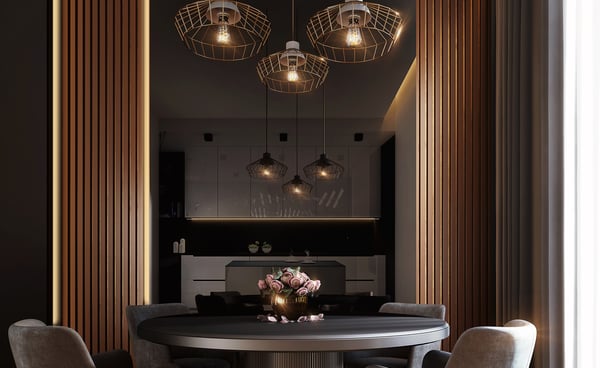Elevating Functionality with Fluted Panels
Discover the elegance and utility of fluted panels in design. Learn how they blend aesthetics with functionality for both interiors and exteriors in modern construction.
ARCHITECTURE
The Essence of Fluted Panels
Fluted panels, characterized by their ridged or grooved appearance, are making a significant mark in the design world for their unique blend of aesthetic appeal and functional benefits. Originating from classical architecture, these panels have been reimagined in modern design, offering a textured surface that plays with light and shadow to create dynamic visual effects. Beyond their beauty, fluted panels also contribute to the acoustic and thermal performance of spaces, making them a favourite among architects and designers.




Versatile Applications in Modern Construction
Interior Elegance
Inside, fluted panels introduce texture and depth to walls, ceilings, and even furniture elements like cabinetry or islands. They are used in residential, commercial, and hospitality projects to create focal points, delineate spaces, or enhance the overall design theme. In office environments, their acoustic properties are particularly valued for reducing noise and creating more comfortable workspaces.
Exterior Impact
Externally, fluted panels are employed to add character and modernity to façades. They can camouflage entrances, provide privacy, or simply serve as an intriguing architectural feature. The interplay of light and shadow across the fluted surface changes throughout the day, giving buildings a living, dynamic appearance.
Material Innovations and Sustainability
The materials used for fluted panels range from wood and metal to composites and polymers, each selected based on the specific requirements of the project, such as durability, weight, and environmental impact. Recent advancements have introduced eco-friendly materials like recycled plastic, bamboo, and sustainably sourced wood, catering to the growing demand for green building materials.
Sustainable Choices
The sustainability profile of fluted panels is largely determined by the material selection and the manufacturing process. For instance, wood panels from responsibly managed forests or recycled composites contribute to a project's green credentials by minimizing the environmental footprint. Additionally, the durability and low maintenance requirements of certain materials, like metal and composite panels, extend the lifespan of the design elements, further enhancing their sustainability.
Design Inspiration and Implementation
Incorporating fluted panels into a project requires a thoughtful approach to balance their visual impact with the overall design aesthetic.
Creating Contrasts
One approach is to use fluted panels as a contrasting element against smooth surfaces, drawing the eye and adding depth to the design. For example, a fluted wood panel can warm up a space dominated by glass and steel, introducing texture and organic lines.
Enhancing Light
Consider the orientation of the fluted panels and the source of natural light to maximize the shadow play on the surface. Vertical flutes can elongate a room, making it appear taller, while horizontal lines can make a space feel wider.
Combining Materials
Mixing materials within fluted panels, such as metal inserts in wooden grooves or vice versa, can create an intriguing aesthetic that adds complexity and richness to the design.
Customization through Color
While the texture of fluted panels is a significant design feature, color plays a crucial role in defining their appearance. Neutral tones can accentuate the shadow effect, while bold colors can transform them into standout design features.
Conclusion: The Renaissance of Fluted Panels
Fluted panels represent a convergence of historical design principles and modern innovation, offering endless possibilities for enhancing both the functionality and aesthetics of construction projects. As architects and designers continue to explore the potential of these versatile elements, fluted panels are set to remain a staple in contemporary design, celebrated for their ability to bring texture, depth, and dynamism to any space. Whether through sustainable material choices, creative applications, or innovative design combinations, fluted panels offer a distinctive way to make a statement in architecture and interior design.
What are Fluted Panels?
Fluted panels are architectural elements that feature vertical or horizontal grooves, known as flutes. They are used for both decorative and functional purposes in interior and exterior design.
What materials are used to make Fluted Panels?
Fluted panels can be made from a variety of materials, including wood, metal, fiberglass, concrete, and composite materials, each offering different aesthetic and functional qualities.
Why are Fluted Panels popular in modern design?
Their popularity stems from their ability to add texture, depth, and visual interest to spaces. Fluted panels also have the versatility to complement both contemporary and traditional design aesthetics.
Can Fluted Panels be used outdoors?
Yes, fluted panels can be used outdoors. Panels made from materials like metal, concrete, and certain composites are particularly suited for external applications due to their durability and resistance to weather conditions.
Are Fluted Panels purely decorative, or do they serve functional purposes as well?
Besides their aesthetic appeal, fluted panels can also serve functional purposes. For instance, they can help with sound absorption, act as privacy screens, and contribute to the thermal insulation of a building.
How are Fluted Panels installed?
Installation methods vary depending on the material and the specific application (wall, ceiling, facade). Generally, panels are either directly attached to a surface using adhesives or mechanical fasteners or installed on a framework that allows for ventilation and insulation.
Can Fluted Panels be customized?
Absolutely. Fluted panels can be customized in terms of size, material, color, and the depth and spacing of the grooves, allowing for a high degree of personalization in design projects.
How do Fluted Panels contribute to a building's sustainability?
When made from sustainable materials like recycled composites or responsibly sourced wood, fluted panels can contribute to a building's sustainability. Additionally, their insulative properties can enhance energy efficiency.
What maintenance do Fluted Panels require?
Maintenance requirements depend on the material. Many fluted panels, especially those made from metal or composite materials, are low maintenance, needing only regular cleaning to maintain their appearance. Wood panels may require more care, including periodic sealing or staining.
How do Fluted Panels affect a room's acoustics?
The grooved surface of fluted panels can help diffuse sound, reducing echoes and improving the overall acoustics of a room. This makes them a popular choice for spaces that require good sound quality without compromising on style.
